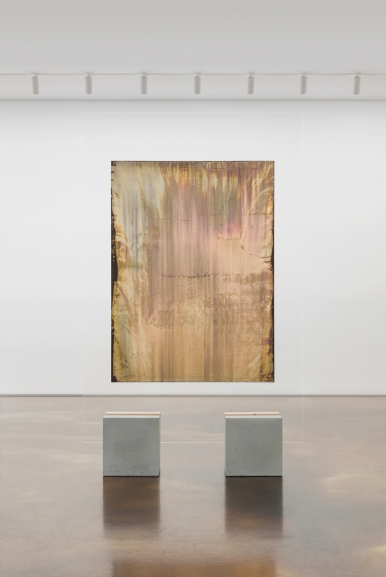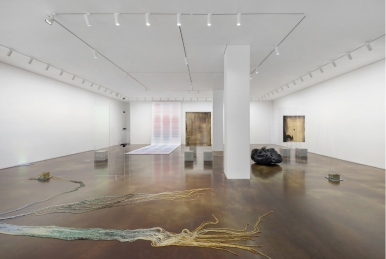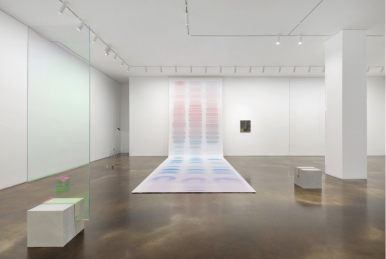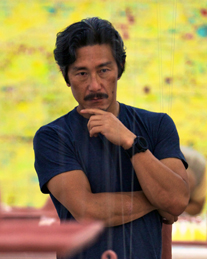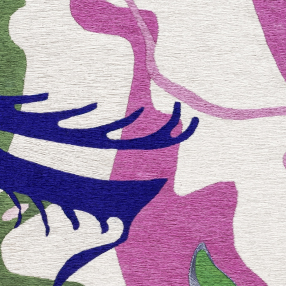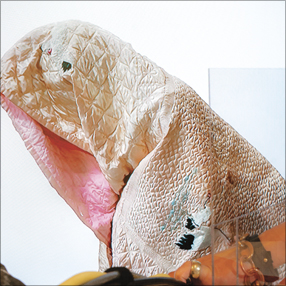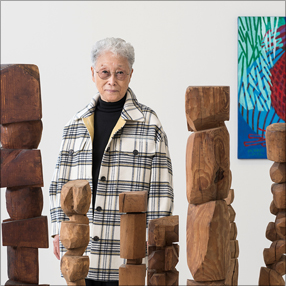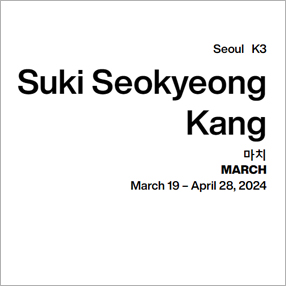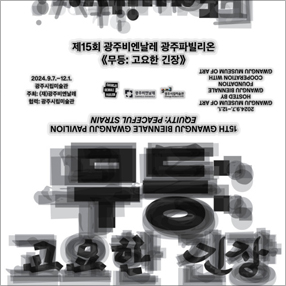본문
-
마이클 주
Barcelona 2017 Silvered epoxy on canvas 160.8 x 118.3 cm Courtesy of the artist and Kukje Gallery 사진: 안천호 이미지 제공: 국제갤러리
-
마이클 주
Cosms (Catalunya 1) 2016-2024 Silvered alabaster and dichroic glass Silvered alabaster: 18.5 x 18.5 x 14 cm Dichoric glass: 30 x 30 x 1.6 cm Courtesy of the artist and Kukje Gallery 사진: 안천호 이미지 제공: 국제갤러리
-
마이클 주
EP Print (v. 2) 2024 Acrylic piezograph on widetone paper 145 x 40 cm Courtesy of the artist and Kukje Gallery 사진: 안천호 이미지 제공: 국제갤러리
-
마이클 주
전시전경
-
마이클 주
전시전경
-
Press Release
국제갤러리는 오는 8월 30일부터 11월 3일까지 K2에서 마이클 주(Michael Joo)의 개인전 《마음의 기술과 저변의 속삭임》을 선보인다. 예술과 과학의 교차점에서 인식과 정체성, 그리고 경계성에 대해 탐구하는 작가는 이번 전시에서 일상적인 지각 기저에서 이루어지는 교환과 연결, 언어화하기 어려운 영향 관계에 주목한다. 전시 제목 《마음의 기술과 저변의 속삭임》은 이를 시적으로 담아낸 문구로, 표면화되지는 않지만 소곤거리듯 작동하는 각종 숨겨진 연결망을 환기하고, 여러 비가시적 관계와 친밀성을 조율하는 이른바 ‘소프트 스킬(soft skill)’에 주의를 돌린다.
전시장에서 처음 마주하는 유리 패널 신작 시리즈는 공간을 분할하기도, 연결시키기도 하는 재료 및 양식에 대한 작가의 오랜 탐구의 결과물이다. 〈 Revider 〉라는 제목으로 엮이는 본 연작은 투명한 아크릴과 더불어 빛의 각도에 따라 다양한 스펙트럼의 색을 띠는 다이크로익 유리(이색성 유리)를 주재료로 사용하고 있다. 작품은 그 너머를 투영하는 투명성을 통해 공간 및 사물을 바라보는 시점을 의식하게 하거나, 변화무쌍한 색상의 표면을 통해서 정적인 사물로서의 작품에서 벗어나 감상자로 하여금 자신의 위치와 시선을 적극적으로 이동시키도록 유도한다. 작가는 패널을 전시장에 창문이나 벽처럼 세워 두거나 서로 잘라내듯 교차시키면서 (반)투명한 건축적 재료가 공간과 사물을 바라보는 시선에 미치는 영향을 실험한다.
한편 작가는 패널에 사물을 삽입하고 예상치 않은 위치에 오브제를 부착하거나 올려둠으로써 오브제와 이를 위한 건축적 지지체 사이의 상하관계를 갱신한다. 〈 Revider for Ganoderms (Yeongjiboseot 1, 3) 〉(2024)에서는 탄화 버섯을 찾아볼 수 있는데, 이는 일명 빈초탄이라 불리는 흰 숯을 전통적인 방식으로 제작한 것이다. 이렇듯 오늘의 기술과 수백 년 전통의 기술을 결합한 결과물이자 땅 속에서 균사체 네트워크를 형성해 식물 뿌리와 공생관계를 맺는 균류는 보이지 않는 저변의 연결망을 상징적으로 보여준다.
또한 〈 Revider with Carbon Doppelganger 〉(2024)에서는 패널이 커다란 바위 조각을 관통한다. 탄소 가루, 흑연, 숯, 우레탄이 섞인 덩어리를 절삭해 만든 이 바위는 2018년 ‘리얼 DMZ 프로젝트(REAL DMZ PROJECT)’ 당시 비무장지대 인근 지역에 거주하는 어린이들이 한탄강 주변에서 수집한 작은 화산석 샘플들의 데이터를 스캔한 것에서 그 형태를 따왔다. 이러한 과정으로 만들어진 바위 조각은 DMZ의 장소적 맥락을 품은 하나의 파편이자 기술적 매개에 의한 인공물이며, 연소 후 구성요소가 변이된 오브제이자 숯이 그러하듯 감상자들과 호흡을 교류하는 물질이라는 복수의 정체성을 갖는다.
전시장 안쪽, 콘크리트 기단에 유리 패널이 끼워진 형태의 작업 〈 Untitled (after LBB) 〉(2024)는 이탈리아 태생의 브라질 건축가 리나 보 바르디(Lina Bo Bardi, 1914-1992)의 ‘유리 이젤’에 대한 오마주이다. 리나 보 바르디는 1968년 상파울루 미술관의 개관 전시를 위해 유리 이젤을 고안했는데, 이는 콘크리트 큐브에 유리판을 끼우고 그 위에 작품을 부착하는 독특한 디스플레이 방식이었다. 병렬로 늘어선 이젤은 전시장을 흡사 작품의 숲처럼 보이게 하고, 이로써 관람자들은 벽에 걸린 작품이 발산하는 역사적 위엄과 교훈적인 아우라를 전달받는 대신 눈앞에 서 있는 작품과 더 가깝고 직접적인 관계를 맺을 수 있게 되었다. 작가는 유리 이젤이 안과 밖의 경계를 구분하는 이동식 건축이며 질적으로 다른 공간의 열림을 알리는 경계면이라는 점에 특히 흥미를 느끼고 이 구조물의 조형미와 개념적 함축을 재조명한다.
본 전시에서 이 유리 이젤에 해당하는 작품은 작가의 또 다른 연작인 실버 페인팅을 위한 플랫폼으로서도 기능하게 된다. 〈 Barcelona 〉(2017)와 〈 The Vagueness Argument 〉(2017)는 작가가 오랜 기간 만들어온 실버 에폭시 페인팅 연작의 일환으로, 전통 사진 기법에서 사용하는 유리 은도금 기술과 판화 제작 과정을 결합한 기법으로 제작되었다. 작가는 독도나 바르셀로나, 뉴욕의 폐공장 등 정치적, 사회적, 혹은 경제적 이유로 소외되거나 논쟁의 대상이 되는 땅 등의 경계 공간을 직접 찾아간다. 그리고 그 장소들의 지면에 에폭시를 바른 캔버스를 고정시킨 후 72시간 동안 노출시켜 그 땅을 ‘본뜨고,’ 이를 은도금하여 해당 지면의 텍스쳐와 형태를 극대화해 작품에 담아낸다. 투사되는 빛의 각도에 따라 다르게 반응하고 주변의 상을 증폭시키는 은의 미묘함과 구체적인 장소를 경화한 에폭시가 결합하며 작품은 장소와 현존을 담아내는 은빛 기록이 된다.
전시장 곳곳에 배치된 네 개의 〈 Cosms (Catalunya 1, 2, 5, 7) 〉(2016-2024)는 지질과 광물, 장소성과 장소 이동에 대한 탐구로서 이번 전시 전체에 흐르는 고고학적인 맥락을 강조한다. 이 작품에는 스페인 카탈루냐에 있는 퇴적암층에서 추출한 앨래배스터(alabaster) 광석이 사용되었다. 퇴적암층은 그것이 매장된 땅의 모양을 반영하고, 암석층의 긴 광석을 잘라내어 만들어진 각 부분은 그 지역의 땅 전체를 품고 있는 작은 풍경 조각이다. 은과 다이크로익 유리의 반사면을 입은 작품은 ‘그때 그곳’을 ‘지금 이곳’의 생동하는 시공간과 연결시킨다.
‘저변의 속삭임’은 보다 개인적인 영역으로 나아가 작가의 뿌리를 이루는 관계와 기억들로 확장된다. 언뜻 보기에 수채화로 그린 획처럼 보이는 〈 EP Cascade 〉(2024)는 실상 옥수수 개체의 유전적 이미지이다. 이는 전기장을 이용하여 다양한 크기와 전하를 가진 입자를 분리하는 실험 기법인 전기영동(electrophoresis)을 통해 만들어졌는데, 작가는 다이크로익 유리의 색 생환을 추출하여 이미지에 입힘으로써 조각들과의 시각적 공명을 만들어낸다. 한 생명의 청사진인 유전자 정보를 가시화하는 이 작품은 식물 생리학자인 어머니로부터 받은 보이지 않는 부드러운 영향을 향한 헌정이기도 하다. 마지막으로, 전시장 한편에 외로이 서있는 〈 Mediator (redux) 〉(2024)는 1980년대에 작가의 가족이 한국에서 미국으로 건너갈 때 가져갔던 이불을 뒤집어쓰고 있다. 이 형상은 1974년 요셉 보이스의 〈 I Like America and America Likes Me 〉 퍼포먼스 중 한 장면에서 따온 것이다. 당시 보이스는 유럽으로 대변되는 서구와 미국이라는 더 넓은 의미의 서구와의 관계에 대한 논평을 위해 따뜻한 보호를 상징하는 펠트 천을 두르고, 갤러리 공간에서 미국의 야생적인 본성과 원주민 문화를 상징하는 동물인 코요테와 3일 동안 지냈다. 이 퍼포먼스에서 보이스는 자신을 유럽과 미국을 매개하는 샤먼으로 상정했는데 이때 천 사이로 튀어나온 굽은 지팡이가 매개 장치로 쓰였다. 마이클 주는 퍼포먼스에 등장한 보이스의 조각적 형상을 차용, 거기에 자신의 개인사가 담긴 퀼트 천을 입히고 48,000개의 돌 구슬로 만든 옥수수 수염을 뻗어 나오게 했다. 이 천은 1970년대에 작가가 물려받은 것으로 세대를 넘나드는 친밀한 가족 관계를 담고 있다. 꽃가루를 생산하고 수분을 돕는 옥수수 수염처럼, 매개자로서의 인물의 형상이 입을 통해 뿜어내는 구슬의 흐름이 작품 사이를 연결하며 이들을 수분시키고 전시 전체가 하나의 조용한 속삭임으로 들리게 한다.
Kukje Gallery is pleased to present Michael Joo’s Soft Skills and Underground Whispers, a new installation of recent works on view from August 30 to November 3, 2024. For his second solo exhibition in Seoul with the gallery since 2017, Joo engages gallery K2 with a dense yet delicate visual field of crystalline surfaces, interesting geometric shapes, and materially charged objects. Continuing his ongoing inquiry into perception, identity, and liminality, Joo mines the intersections of art, science, and belief as the exhibition’s methodology emphasizes the exchanges, connections, and ineffable relations of mutual influences that occur at the subliminal level of perception.
A poetic phrase that encapsulates these themes, the exhibition title “Soft Skills and Underground Whispers” hints at this range of hidden networks that operate like whispers vibrating from underneath, and calls viewers’ attention to the soft skills that contour invisible relations and intimacies. Upon entering the gallery, the viewer is first presented with a new group of works from the artist’s Revider series, which embodies Joo’s ongoing use of materials and modalities that both separates and connects space. Constructed from both clear acrylic and dichroic glass—which displays a wide spectrum of colors visible from different viewing angles—the works present transparent and kaleidoscopic surfaces that visually animate the static object. For Joo, the unstable optical quality of the materials encourages the viewer to engage by shifting one’s position and gaze.
Objects delicately mounted on their surfaces appear suspended in space, visible in their relationship to each other. Upon closer inspection the rich black objects in Revider for Ganoderms (Yeongjiboseot 1, 3) (2024) reveal themselves to be carbonized reishi mushrooms made using a process that Joo developed with traditional white charcoal makers—merging new and centuries-old technologies. The material transformation to pure carbon takes the object beyond the point of combustion into a material that is so hyperporous that it can purify air and water at an ionic level, connecting the seemingly inert with the continuously active, while visually and spatially alluding to the invisible subterranean networks that connect fungi with their surrounding ecologies. Central to the grid-like yet lyrical arrangement of panels is Revider with Carbon Doppelganger (2024), a crystalline acrylic construction which, depending on one’s perspective, is either being penetrated by or merged with a large, sculpted boulder. Carved from a composite block of carbon dust, graphite, wood charcoal, and urethane by a seven-axis robotic arm, the stone takes its form directly from volcanic rocks collected by children living in the area bordering the Demilitarized Zone along the Hantan River during Joo’s 2018 REAL DMZ PROJECT. Using scanned details from these site-specific samples, the stone accrues multiple identities: it is a synecdochic part that speaks to the larger context of the DMZ, an artifact born out of technical mediation, a burnt object whose components have been mutated as a result of combustion, and a material that is comprised of the elemental (carbon, graphite), the residual (charcoal), and the artificial (urethane). This destabilizing of the hierarchical relation between an object and its support is another clear example of Joo’s resistance to containment and his commitment to continuously engaging with the entangled narratives found in and perpetuated by material artifacts.
Installed further in the K2 space is Untitled (after LBB) (2024) which pays homage to Joo’s long-standing regard for the “glass easels” designed by the Italian-born Brazilian architect Lina Bo Bardi (1914–1992). Conceived for the opening exhibition of the Museu de Arte de São Paulo (MASP) in 1968, the “glass easel” refers to Bo Bardi’s original display system consisting of a pane of glass wedged into a concrete cube, which together form a self-supporting structure for an artwork attached to the sheet of glass. Eliminating the historical authority and didactic aura traditionally associated with the display method of works hung on the wall, the glass easels invite a more intimate and direct relationship with an artwork that stands in close proximity to each viewer. Joo’s interpretation of this as a portable and provisional architecture that blurs the boundary between the inside and outside, as well as its status as a liminal plane signaling an opening to another kind of space, has been a direct influence on the artist’s strategies of display, ranging from the glass ropes and stanchions of the Expanded Access series (2001–present) to the silvered glass and polycarbonate shield series such as in Plexus (2013) and Indivisible (2010–2012). In two of the works displayed on these supports, Barcelona and The Vagueness Argument (both 2017), metallized, reflective surfaces fluctuate in silver, gold, and copper hues, shifting according to the viewer’s position and movement and further connecting them with the surrounding environment. Part of an ongoing series of silvered epoxy paintings, the works continue Joo’s decades-long research developing an innovative method that merges glass silvering techniques familiar to traditional photography with printmaking processes. The poetic potential and physicality of combining these two mediums allows Joo to create site-specific “prints” of surfaces in remote sites such as abandoned structures, borderlands, and contested territories, an environmental record “fixed” over long duration in the cured epoxy that can then be retrieved and silvered. In doing so, the artist has invented what he describes as an “image making process to amplify presence and merge subject with context,” marrying the subtlety of the silver and the concrete relief of the cured epoxy, to reveal and highlight the resulting textures and forms of his locations.
Placed at intentional intervals throughout the installation, the series of works Cosms (Catalunya 1, 2, 5, 7) (2016– 2024) also explores site by investigating the discipline of archaeology, framing subjects including subterranean geology, identity, place, and migration. The works highlight the artist’s interest in the science of excavation and how the different forensic categories of biofact, ecofact, and geofact establish the rubric of authority that surrounds history, an interest that underpins the entire exhibition. Resembling broken architectural columns, Cosms (Catalunya 1, 2, 5, 7) consist of compact blocks of alabaster stone, carefully cut to reflect their relationship to the landscapes beneath which they are typically buried. Silvered and placed on dichroic glass plates, the carved works amplify their physical origin, encouraging the viewer to connect to a sense of deep time and physical scale.
The complex mycorrhizal logic suggested by the title “Underground Whispers” extends to a more deeply personal realm in the final two works that anchor the exhibition. In EP Cascade (2024), what appears to be a sumptuous streak of watercolor at first glance, is in fact an AI modified image derived from a process of DNA molecular separation using electrophoresis, separating molecules by mass to assist in determining genetic identities. The color palette of the work was based on that of the dichroic glass spectrum and applied to the image profile, creating a visual resonance with the sculptures. As a work that visualizes genetic information and is therefore a blueprint of a life, EP Cascade is also a tender tribute to the influence of the artist’s mother, who was a plant physiologist and electrophoresis specialist, evoking the idyllic waterfalls he and his siblings experienced as children in upstate New York. Finally, the lone figurative form suggested in Mediator (redux) (2024) incorporates a family heirloom brought over to the US from Korea in the 1980s. Echoing the sculptural form that appeared in Caroline Tisdall’s documentation of Joseph Beuys’ iconic 1974 performance, I Like America and America Likes Me, a critique of European and American relations as well as an exploration of the conflicting mystique and reality of American identity, the subtle sheen of the pink sateen quilt in Joo’s work appears to fall and drape naturally over an absent human body. The artist takes this evocation of generational personal history further by incorporating a dense strand of stone beads that seem to come from within the figurative shroud. Like pollinating corn silk, the networked spray of lines emanating from the work weaves the interstices of other works into fertile connections, as if facilitating the cross-pollinations and transmissions of the softest of whispers.전시제목마이클 주: 마음의 기술과 저변의 속삭임
전시기간2024.08.30(금) - 2024.11.03(일)
참여작가 마이클 주
관람시간10:00am - 06:00pm / 일, 휴일 10:00am - 05:00pm
휴관일매주 월요일
장르회화, 조각
관람료무료
장소국제갤러리 Kukje Gallery (서울 종로구 소격동 58-1 K2)
연락처02-733-8449
-
Artists in This Show
-
1966년 뉴욕 이타카출생
-
국제갤러리(Kukje Gallery) Shows on Mu:umView All
Current Shows
-
여세동보 與世同寶: 세상 함께 보배 삼아
간송미술관
2024.09.03 ~ 2024.12.01
-
2024 광주비엔날레 기념특별전 《시천여민 侍天與民》
광주시립미술관
2024.09.06 ~ 2024.12.01
-
무등: 고요한 긴장 Equity: Peaceful Strain
광주시립미술관
2024.09.07 ~ 2024.12.01
-
제15회 광주비엔날레 네덜란드 파빌리온 《두개의 노래 Two Songs》
광주시립미술관
2024.09.07 ~ 2024.12.01
-
2024 아르코미술관 × 레지던시 해외작가 초대전 《나의 벗 나의 집》
아르코미술관
2024.11.21 ~ 2024.12.01
-
두 개의 숨: 권영우·김창열
제주도립 김창열미술관
2024.08.27 ~ 2024.12.01
-
김창열: 물방울, 찬란한 순간
제주도립 김창열미술관
2024.08.27 ~ 2024.12.01
-
미디어아트 스크리닝 《플라스틱 풍경》
영화의전당
2024.11.22 ~ 2024.12.03




